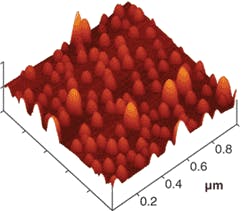Quantum dots can be thought of as nanometer-scale islands that confine electrons and holes in three dimensions; quantum-well-based semiconductor lasers confine carriers along one axis. The three-dimensional aspect of the quantum dot means that energy levels in each dot are discrete, like atoms, whereas bulk and quantum-well structures exhibit continuous dispersion ranges. As Y. Arakawa and H. Sakaki stated in the pioneering paper they published in Applied Physics Letters in 1982, it was hoped that this unique feature would mean that the gain spectrum of an array of quantum dots would be narrower and the peak gain and differential gain higher than those of other structures.
In practice, however, the modal gain from quantum dots turned out to be weaker than expected. Researchers now combine numerous layers of quantum dots to overcome this problem; a review of papers presented at the 2005 European Conference on Optical Communications (ECOC) and this year’s OFC/NFOEC reveals that 6 to 10 layers of dot arrays are typical. The arrays usually are created via molecular beam epitaxy using InAs in a GaAs matrix (InP also may be used); given the right deposition environment, the dots will form spontaneously (see figure on page 1).
With the modal gain issue resolved, proponents began touting the benefits quantum dots succeeded in providing. These boons included high temperature stability, broad gain spectrum, fast carrier dynamics, and low jitter-as well as an ability to lase at the 1,300- and 1,550-nm wavelengths interesting to telecommunications equipment designers.
Researchers have offered dots for a variety of applications including lighting and medical equipment, where they would provide an alternative to superluminescence LEDs. Within the telecom realm, significant work is ongoing in mode-locked lasers, amplifiers (both as pumps for EDFAs as well as integration into semiconductor optical amplifiers [SOAs]), tunable lasers, and VCSELs. Mode-locked lasers, both passively and actively locked, have garnered particular attention recently. These devices could be used for all-optical clock recovery at high speeds; their ability to emit very short pulses, combined with optical TDM, could prove useful in ultrahigh-speed signal transmission as well. Meanwhile, as reported last month, Fujitsu is looking at dot-based SOAs for future use with WDM-PON (see “Industry Mulls over WDM-PON Technology,” Lightwave, August 2006, page 1).
Asian and European centers currently provide most of today’s quantum dot research. For example, Fujitsu has examined quantum dots not only in SOAs but in lasers as well. At this year’s OFC, the company presented a paper in collaboration with Japan’s Optoelectronic Industry and Technology Development Association and various branches of the University of Tokyo describing the use of a 10-stack quantum dot laser to provide 10-Gbit/sec transmission over 300 m of multimode fiber. Uncooled lasers are a plus in the low-cost enterprise environment, and quantum dot technology’s low temperature sensitivity makes such a device possible. The laser in question maintained good eye performance up to 80°C with the help of electronic dispersion compensation.
In Korea, the Electronics and Telecommunications Research Institute also has examined the technology. A paper at ECOC last year described work on a 1,550-nm device capable of supporting 2.5-Gbit/sec data rates. This laser used seven dot-array stacks and was used to create a Fabry-Perot-type device that showed better temperature stability than a Fabry-Perot with a quantum well structure.
Europe also hosts several research centers working on quantum dots. Alcatel-Thales III-V Lab has done extensive work in this area, using two interesting variants. One is the “quantum dash,” in which the dot islands are elongated; the other is embedding quantum dots into quantum wells to create Fabry-Perot devices. The dots used in this latter research avenue have only six layers; the resulting structure is called “dot in a well,” or DWELL. Often working with such partners as the CNRS Laboratory of Photonics and Nanostructures, the lab recently has presented papers on subpicosecond pulse generation at 1,550 nm using a passively locked quantum dot laser; similar pulse generation, but with a 134-GHz repetition rate, using a quantum dash structure; and directly modulated 10-Gbit/sec operation in C-band up to 75°C.
NL Nanosemiconductor (www.nanosemiconductor.com), headquartered in the United States but with its main research facilities in Dortmund, Germany, also has worked extensively with quantum dots. In addition to 1,300-nm passively mode-locked lasers (working with the University of Cambridge), the company recently has reported work on VCSELs (more development is necessary here, the company admits) and its own attempts at developing a 10-Gbit/sec device. In this last work, the company (collaborating with the University of Cambridge and the Heinrich Hertz Institute) looked at transmission over both singlemode and multimode fiber. With multimode, the device demonstrated error-free transmission with a 2.5-dB transmission penalty and a 20-µm offset launch. The device performed well over 4 km of singlemode, with a transmission penalty of 1.8 dB.
While much of the noise in quantum dot research emanates outside of North America, the continent isn’t totally quiet. For example, the University of Toronto has developed a novel approach to the creation and deployment of quantum dot structures. The university has developed an IR colloidal quantum dot technology that enables the dot arrays to be applied using a variety of methods, including spin casting, spray coating, and blade or drop casting. University researchers have developed a ring laser in a capillary tube using dots created with lead sulfide. The laser emits in the 1,550-nm range.
Finally, the United States boasts the first company to commercialize quantum dot technology. Zia Laser (www.zialaser.com), a spinout from the University of New Mexico, offers passively mode-locked lasers operating in the 1,200- to 1,340-nm range with a “multigigahertz” repetition rate in a 14-pin butterfly package. The company (which did not respond to queries by press time) says the laser features less than 3-psec RMS timing jitter and a pulsewidth of less than 10 psec. It provides 20-mW average optical power and requires only DC voltage bias during operation.
After a few years as the only game in town, Zia should soon see competition from other firms nearing commercialization. Fujitsu and Mitsui announced this past April that they will collaborate to create QD Laser Inc. The new company will target the optical access and enterprise spaces. While the release announcing the new company did not provide a timeline for development, earlier statements from Fujitsu indicate that the company hoped to have commercial devices based on quantum dots by 2007.
NL Nanosemiconductor also has announced its intention to go commercial. It announced in June that it has a quantum-dot-based device “currently being put into production” compatible with arrayed waveguide grating technology that could be used for WDM applications. The singlemode CW laser offers a spectral width greater than 20 nm and operates between 1,200 and 1,320 nm. According to Alexey Kovsh, chief operating officer at the company, the laser provides output with a very uniform shape-less than 3 dB of modulation at 0.5-nm resolution. NL Nanosemiconductor subsequently announced that it had pushed the spectral width to 75 nm. In addition to WDM applications, the company also has its eyes on coherence tomography applications in imaging systems.
With the advent of three companies working toward bringing the technology to market, there appears to be hope that quantum dots may establish themselves within optical communications applications. However, significant challenges remain. First, the technology itself must continue to mature and match, if not exceed, the capabilities of current technology. Some of the applications for which quantum dot devices have been demonstrated-such as ultrahigh-speed communications-currently involve much more theory than practice. This condition doesn’t bode well for companies looking to ramp revenues in the short term, unless nontelecom applications can be found.
It appears that more than 20 years of research and discussion have transformed quantum dot lasers from scientific curiosities to the brink of commercial availability from multiple sources. However, companies hoping to supply such lasers to the market may discover that the challenges technology development presented may pale in comparison to those commercial acceptance will pose.
